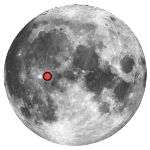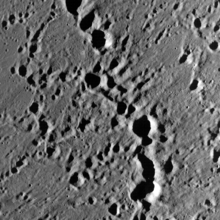Stadius (crater)
Stadius is a ghostly remnant of an ancient lunar impact crater that has been nearly obliterated by basaltic lava flows. It was named after Flemish astronomer Johannes Stadius.[1] It lies to the southwest of the much younger crater Eratosthenes, at the north edge of Mare Insularum where the mare joins Sinus Aestuum. To the west is the prominent ray crater Copernicus, and multiple secondary craters from the Copernican ejecta cover this area. To the northwest is a chain of craters that continue in a roughly linear formation until reaching Mare Imbrium.

.png) LRO mosaic image | |
| Coordinates | 10.48°N 13.77°W |
|---|---|
| Diameter | 69 km |
| Colongitude | 13° at sunrise |
| Eponym | Johannes Stadius |
Only the northwestern rim of Stadius remains nearly intact, and it joins with a north-running ridge line that reaches the western rampart of Eratosthenes. The remainder of the formation forms a ghostly trace of the original rim, created from a few rises in the surface, and there is no indication of a central peak. The flat crater floor is pock-marked by craterlets, many of which were generated by secondary impacts from the creation of Copernicus.[2]
Satellite craters

By convention these features are identified on lunar maps by placing the letter on the side of the crater midpoint that is closest to Stadius.
| Stadius | Latitude | Longitude | Diameter |
|---|---|---|---|
| A | 10.4° N | 14.8° W | 5 km |
| B | 11.8° N | 13.6° W | 6 km |
| C | 9.7° N | 12.8° W | 3 km |
| D | 10.3° N | 15.3° W | 4 km |
| E | 12.6° N | 15.6° W | 5 km |
| F | 13.0° N | 15.7° W | 5 km |
| G | 11.2° N | 14.8° W | 5 km |
| H | 11.6° N | 13.9° W | 4 km |
| J | 13.8° N | 16.1° W | 4 km |
| K | 9.7° N | 13.6° W | 4 km |
| L | 10.1° N | 12.9° W | 3 km |
| M | 14.7° N | 16.5° W | 7 km |
| N | 9.4° N | 15.7° W | 5 km |
| P | 11.8° N | 15.2° W | 6 km |
| Q | 11.5° N | 14.8° W | 4 km |
| R | 12.2° N | 15.2° W | 6 km |
| S | 12.9° N | 15.5° W | 5 km |
| T | 13.2° N | 15.7° W | 7 km |
| U | 13.9° N | 16.4° W | 5 km |
| W | 14.1° N | 16.4° W | 5 km |
References
- "Stadius (crater)". Gazetteer of Planetary Nomenclature. USGS Astrogeology Research Program.
- Wood, Chuck (October 26, 2007). "Before and After". Lunar Photo of the Day. Archived from the original on October 16, 2014. Retrieved 2007-10-29.
- Andersson, L. E.; Whitaker, E. A. (1982). NASA Catalogue of Lunar Nomenclature (PDF). NASA RP-1097. Archived from the original on 2014-10-06.CS1 maint: ref=harv (link) CS1 maint: BOT: original-url status unknown (link)
- Bussey, B.; Spudis, P. (2004). The Clementine Atlas of the Moon. New York: Cambridge University Press. ISBN 978-0-521-81528-4.CS1 maint: ref=harv (link)
- Cocks, Elijah E.; Cocks, Josiah C. (1995). Who's Who on the Moon: A Biographical Dictionary of Lunar Nomenclature. Tudor Publishers. ISBN 978-0-936389-27-1.CS1 maint: ref=harv (link)
- McDowell, Jonathan (July 15, 2007). "Lunar Nomenclature". Jonathan's Space Report. Retrieved 2007-10-24.CS1 maint: ref=harv (link)
- Menzel, D. H.; Minnaert, M.; Levin, B.; Dollfus, A.; Bell, B. (1971). "Report on Lunar Nomenclature by the Working Group of Commission 17 of the IAU". Space Science Reviews. 12 (2): 136–186. Bibcode:1971SSRv...12..136M. doi:10.1007/BF00171763.CS1 maint: ref=harv (link)
- Moore, Patrick (2001). On the Moon. Sterling Publishing Co. ISBN 978-0-304-35469-6.CS1 maint: ref=harv (link)
- Price, Fred W. (1988). The Moon Observer's Handbook. Cambridge University Press. ISBN 978-0-521-33500-3.CS1 maint: ref=harv (link)
- Rükl, Antonín (1990). Atlas of the Moon. Kalmbach Books. ISBN 978-0-913135-17-4.CS1 maint: ref=harv (link)
- Webb, Rev. T. W. (1962). Celestial Objects for Common Telescopes (6th revised ed.). Dover. ISBN 978-0-486-20917-3.CS1 maint: ref=harv (link)
- Whitaker, Ewen A. (2003). Mapping and Naming the Moon. Cambridge University Press. ISBN 978-0-521-54414-6.CS1 maint: ref=harv (link)
- Wlasuk, Peter T. (2000). Observing the Moon. Springer Science & Business Media. ISBN 978-1-852-33193-1.
External links
| Wikimedia Commons has media related to Stadius (crater). |
- Stadius at The Moon Wiki
- Wood, Chuck (September 28, 2004). "Unknown Luna 19". Lunar Photo of the Day. - featuring three released photos from Luna 19 from 1971 - it includes Stadius in the third one
- Wood, Chuck (March 24, 2005). "Floods and Buckshot". Lunar Photo of the Day.
- Wood, Chuck (January 26, 2007). "Before and After". Lunar Photo of the Day. Archived from the original on June 14, 2011.